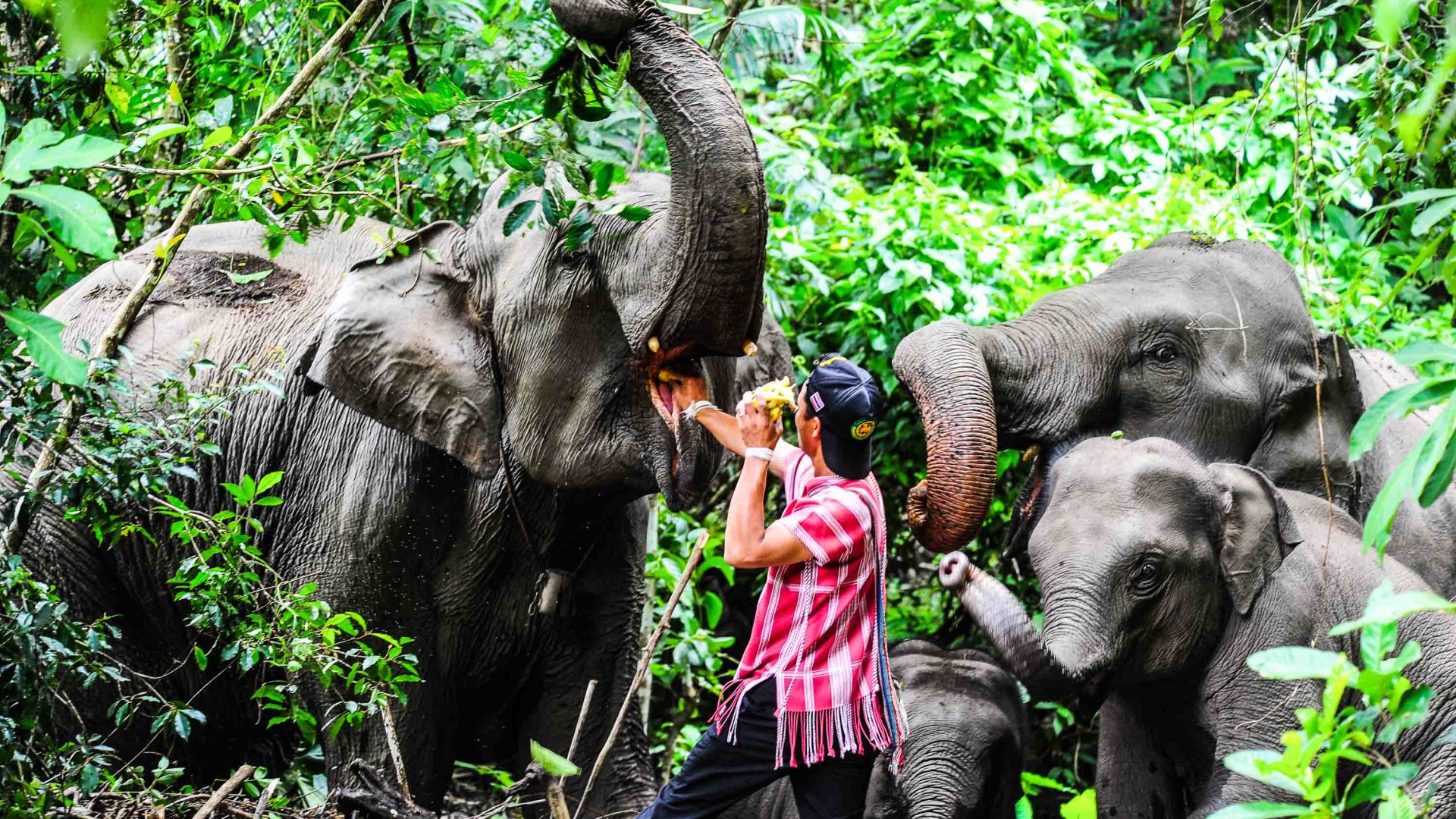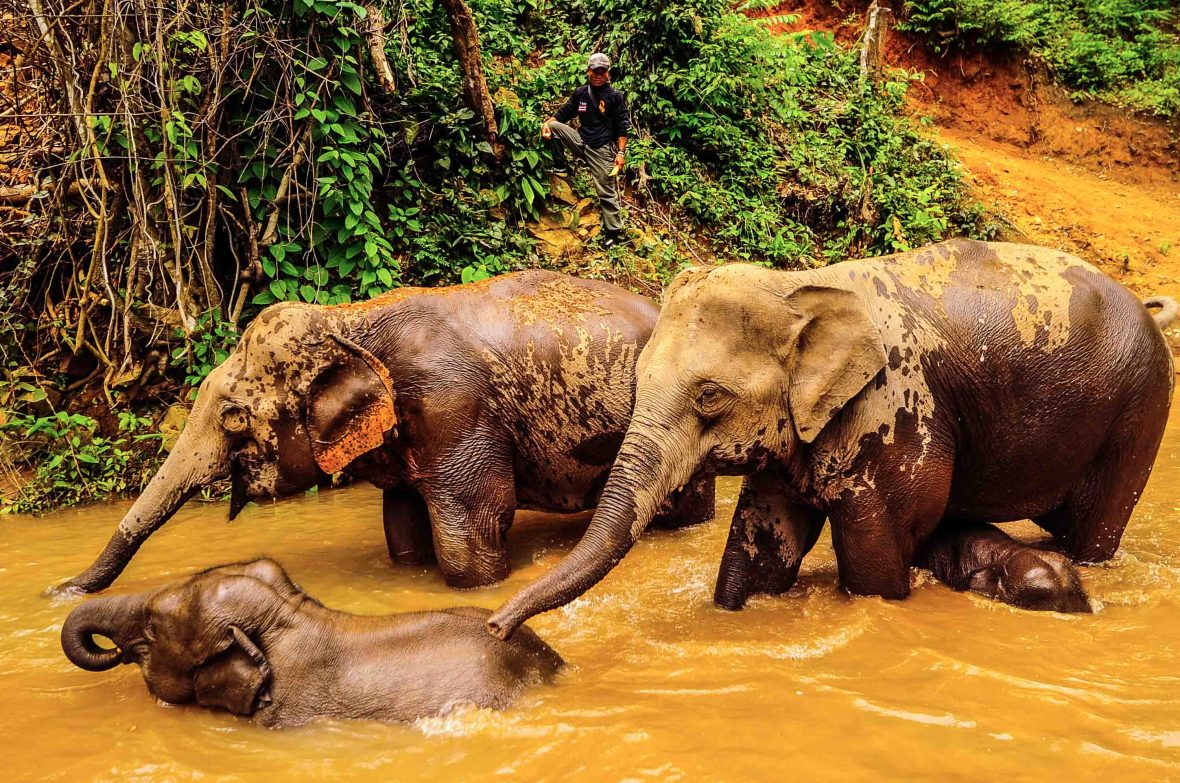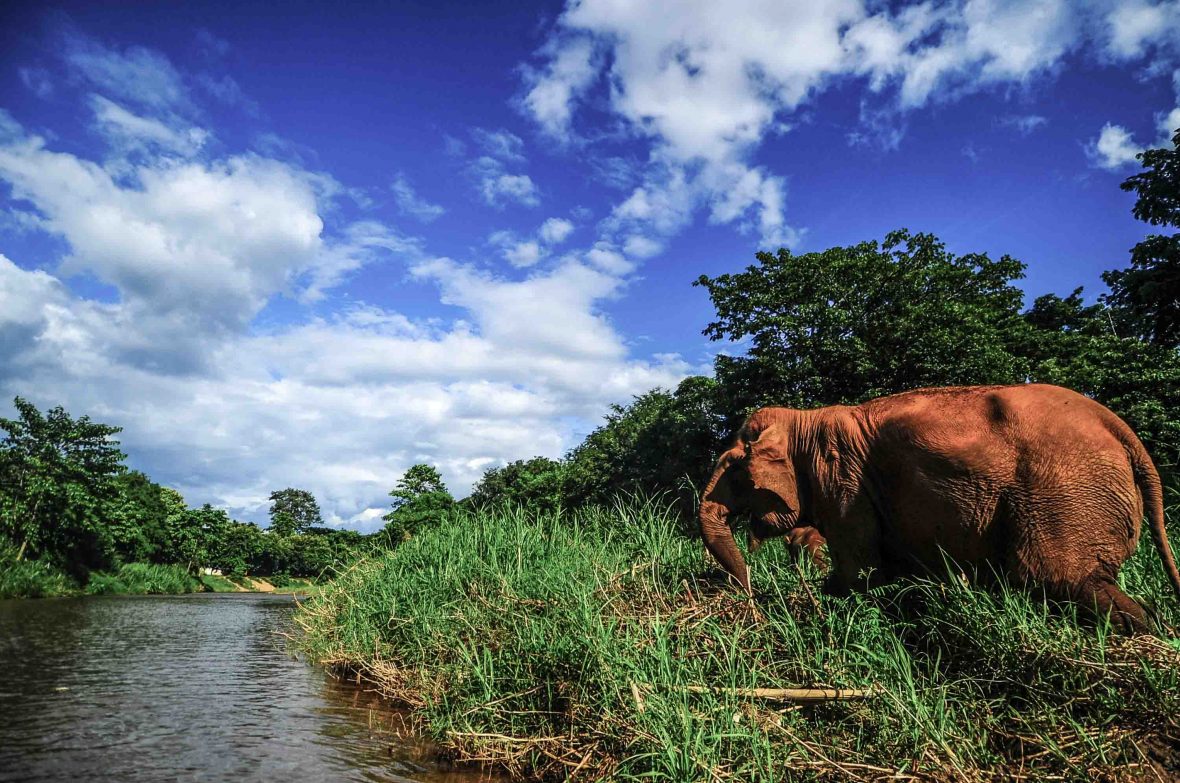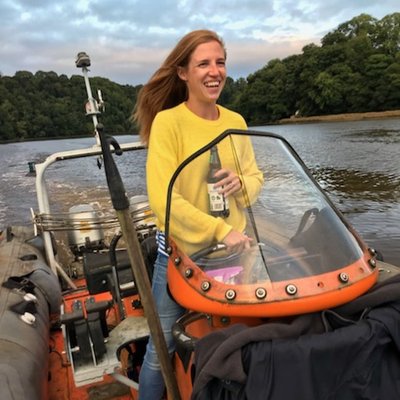
A new project in Thailand aims to address issues around elephant tourism ethics with a pioneering model. But can truly ethical treatment of elephants ever go hand-in-hand? Mark Stratton investigates.


A new project in Thailand aims to address issues around elephant tourism ethics with a pioneering model. But can truly ethical treatment of elephants ever go hand-in-hand? Mark Stratton investigates.
There’s a minivan of travelers parked outside the office of an elephant sanctuary in Chiang Mai. Beneath the words ‘ethical’ and ‘no riding,’ the vehicle’s artwork depicts swimwear-clad tourists clambering over an elephant laying prone in the river. There’s no mention that water is a bowel-relaxant for elephants—they’re literally posing for selfies in liquid excrement.
As elephants are subject to the same spiteful control as they would if being ridden, I suggest to the visitors that they refrain from the bathing and explain why. The reality is if this becomes the new norm for ‘ethical sanctuaries,’ it will perpetuate future generations of tourist-focused elephants to endure the same iniquitous captivity. Abuse, redefined.
A young woman looks up, angry. “Why don’t you fuck off. You’re ruining our day,” she snarls.

Had they done even a little research, they would have found that alternative cruelty-free elephant attractions are emerging, and particularly around Chiang Mai. One example is the new homestay project between an American non-profit, Gentle Giants, and the ethnic Karen people of Om Koi, who own 59 elephants. The homestay revenue compensates the Karen to not send their elephants away to riding camps or to venues where they will end up in grotesque circus performances. Instead, their elephants browse wild jungles surrounding their community, chain-free, and without harsh treatment.
The scale of Thailand’s elephant welfare crisis was laid bare during COVID-19. Over half of Thailand’s estimated 5,000 elephants exist in captivity, many in riding camps where they are overworked and brutalized. But when China’s borders closed, tourism to the riding camps dried-up and led to many of them folding. The elephants returned back to the communities who own and rent them for income. Many went hungry as owners could not afford to maintain them.
What many don’t see is that tourist elephants live their lives in chains. As youngsters, they have their spirits ‘crushed’ by the practice of pajaan, during which they’re beaten and stabbed by mahouts using bullhooks until they equate compliance with fear. They develop neurological issues alongside other traumas. My own campaign to free Bunka, a 15-year-elephant living alone in an inadequate zoo enclosure in Armenia, has been another way I’ve been attempting to raise awareness. Females are forcibly put to bulls and their babies removed—a loss these emotionally intelligent animals will never forget.
Ethical sanctuaries offer refuge to elephants who have endured years of abusive labor. But what does ‘sanctuary’ really mean, and can elephant tourism ever truly be ‘ethical’?
There are only two ways elephant tourism can be ethical, according to Dr Mark Jones, head of policy at Born Free. “Truly responsible elephant tourism consists either of watching wild elephants in their natural habitat in a way that has no negative impact on the animals or their ecosystem,” he says, “or safely viewing those elephants who cannot live in the wild but in genuine well-managed sanctuaries that offer optimal welfare standards.”
“Elephants don’t need tourists to bathe them. They have trunks for this. Tourists throw buckets of water in the eyes of elephants and believe it’s ‘ethical’ to ride on them bareback rather than in a heavy basket. Either way, the elephant is abused.”
- Lek Chailert, conservationist
For Duncan McNair, CEO of Save the Asian Elephant (STAE), there’s a sense that it just has to work. “Elephant tourism can be ethical—this may be the last opportunity to save them,” he tells me. “They’re in a very bad situation in Thailand. The few beacons of hope are these nurturing genuine sanctuaries.” In fact, STAE are currently lobbying for a new law, the Asian Elephant Tourism Bill, to prohibit UK companies advertising and selling holidays that feature abusive attractions.
“Whilst there are a small number of ethical tour-operators who don’t advertise abusive attractions some 1200 are showcasing brutal elephant venues,” says McNair. His bill is currently held up in parliament by libertarian elements of the government who, he says, insist ‘consumer choice’ is more important than elephant welfare.
As a long-time observer and appreciator of these gentle giants, I’ve noticed that watching elephants in the wild has become increasingly difficult in Thailand. Numbers of Elephus maximus have declined across their entire Asian range—McNair suggests around 45,000—precipitating their listing as critically endangered by the IUCN. It’s a far from the start of last century when it was estimated in Thailand alone, there were 100,000 roaming wild around 1900.
“There are just pockets here and there in Thailand, and no wild corridors for them to migrate,” says Darrick Thomson. Thomson runs Thailand’s largest sanctuary, Elephant Nature Park (ENP), with his partner and its founder, Lek Chailert, Thailand’s world-renowned elephant conservationist. “They live in a state of flight, always running with fewer places to go and encountering human-wildlife conflict.”
“Elephants don’t need tourists to bathe them,” she says. “They have trunks for this. Tourists throw buckets of water in the eyes of elephants and believe it’s ‘ethical’ to ride on them bareback rather than in a heavy basket. Either way, the elephant is abused.”
ENP currently rehomes 118 rescued elephants. Riding, bathing, and touching are not allowed. You can volunteer at the sanctuary where the elephants have the run of open plains and a river. At night, to stop them roaming too far, the elephants sleep in chain-free shelters.
However, ethical sanctuaries are dependent on visitor funding and face great pressures to survive as tourism slowly recovers, post-pandemic. Then, as you look at the sums, you realize the predicament.
And then you have this term: ‘sanctuary.’ A word that’s become wide open to manipulation by camp owners, hoodwinking travelers from societies who may be aware that riding is taboo, but who don’t realise that other activities, such as bathing, also come with problems. Chailert says many of the new attractions setting up are appropriating the word ‘ethical’—but behind the tourists’ backs, the elephants remain chained and beaten.

Here’s one example. Pattaya Elephant Sanctuary in southern Thailand needs 1,000-2,000 baht (USD$27-54) per day to provide supplementary food—pineapples and bananas—to their three rescued elephants in their 7.5-acre sanctuary where visitors can walk through a native jungle habitat, accompanied by Thangthai, Somkid, and Frank, well-cared for, loved, and all rescued from abusive tourism. Juvenile Frank began life as a street-begging elephant.
“Currently we get a few tourists each week, so we struggle to raise money,” says owner Renu Rothom. “Riding camps get far more tourists.”
Rothom dreams of hosting 10 elephants, but buying extra land is expensive. They also face the dilemma of Frank, just eight years old, and growing fast. Biologically, bulls leave the natal herd aged eight and upwards to forge a solitary life. It would be dangerous to keep him with visitors around. “Frank will be big soon. He will have to go deeper into the jungle to find his own space,” says Rothom. “But it’s a problem as he will come into contact with communities who will hurt him.”
During the pandemic, Chailert’s Save the Elephant Foundation, assisted by the American Trunks Up foundation, supported a number of these cash-strapped sanctuaries—in all, they helped 1,800 elephants across Thailand, including those at riding camps and within Indigenous ownership communities.
ENP is an example of how a sanctuary can work effectively. Kabu was rescued in 2015. Her leg was smashed at a logging camp, then after being forced to breed, she lost both her calves. One-year old Cha-ba arrived malnourished—from birth, she’d been chained to her mother while she was being ridden. Now, Cha-ba careens around ENP like a carefree toddler. She’s recovering better than Bai Toey, a rescued seven-year-old who exhibits a neurosis known as stereotypies, repetitively swaying her body from side-to-side.
“When people see this behavior, the mahouts tell tourists they’re ‘dancing’,” says Chailert, “but they’re traumatized from being chained.”
Could Thai law not protect them from such treatment? “In law, captive ones are considered transportation—on the same footing as buffalo,” explains Chailert. “We put elephants in every temple in God’s name and pray to them. But in real life we abuse them, it’s so confusing.”
I ask Chailert if she feels the pandemic has helped amplify the issues. Yes, but she worries elephant tourism will just return to pre-COVID-19 abuses. “During the pandemic, a mahout bought a mother and baby to us and pleaded for help,” she recalls. “But tourism remains a stumbling block for change and when COVID-19 measures eased, he put the mother to breed, and her baby was taken away for ‘training’. It was heartbreaking.”
ENP also hosts 10 bulls, who are kept separated in two-acre, chain-free enclosures, cared for by Darrick Thomson. Hope is a 22-year-old, five-tonne colossus who arrived here orphaned after his mother died at a riding camp. He patrols his fence with a surefooted slow-paced swagger.
Thomson says it’s rare that bulls are receptive to commands. “Two acres is the bare minimum for bulls,” he says. He’d like to buy a neighbor’s 17 acres, but he’s asking $2.5million for it. Going forwards, finding the funds to expand sanctuaries size and rescue more elephants from abusive tourism is a challenge to this whole ethical sector’s growth.
“We’re not yet a true ‘sanctuary’,” says Thomson. “We have 300 acres for 120 elephants. To be a true sanctuary, they need a large ecosystem that can support them and enable them to disappear into their natural surroundings. But at least we can give them a better life away from the norm of being shackled, enduring beatings, and no shelter.”
“We believe Om Koi can break the mould of elephant tourism, witnessing how incredibly beautiful it is to see them express themselves and interact without fear in their own magical habitat.”
- Diana Muñoz, Gentle Giants
Dutchman, Edwin Wiek, came to Thailand in 1989 to set up a manufacturing business. In 2001 he rekindled a childhood passion for caring for animals and founded Wildlife Friends Foundation Thailand which rehomes elephants, including a lone bull: 14-year-old Khan Kluey, rescued from street begging in Cha Am. Visitor are kept away from his 7.5-acre enclosure because this traumatized youngster hurls stones at anybody getting too close.
Might Edwin’s rescued elephants one day be released to restock wild populations?
“It’s unlikely in Thailand,” he says. He feels the national parks are doing their best to maintain Thailand’s fragmented wild population but suggests that rewilding captive elephants might be best attempted overseas. “There may be the possibility to release in neighboring countries such as Vietnam, Laos, and Cambodia, where they have more wild forest,” he says.
“But for now, we need to stop breeding them in captivity to end the supply to riding camps,” says Wiek. “Every extra born calf means another 60-70 years of captivity.”
Just as Thailand’s slow progress towards ethical elephant tourism began to feel like it can only ever be about improving their welfare conditions, along came Om Koi. Offering a new vision of sanctuary, they also address the fundamental cause of their enslavement—namely that elephants make money for humans.
Eco-volunteers come to homestays in Tung Ton Ngiaw village to stay with the Karen, a Sino-Tibetan speaking culture along the Myanmar-Thai border. Immersed in their culture, they enjoy walks to watch the villagers’ 59 captive elephants, including 16 babies (local wild bulls have been active), at peace in the surrounding jungle. You watch the elephants use their extraordinary sense of smell to autonomously decide what they want to eat from nature’s larder. They wallow happily in muddy rivers and enjoy minimal human contact.
The project recognizes that the Karen rely on money from renting out their elephants into unethical practices. “We were well aware of the terrible situation for elephants and mahouts during COVID-19 so started a sponsorship program to help both,” says Diana Muñoz, co-founder of Gentle Giants. During the pandemic, they have been fundraising $37,000 per month to compensate Om Koi’s elephant-owning families to not send them away into tourism or logging. The mahouts agree to stop using bullhooks or chains and leave them in the jungle. The longer-term plan is the project may be subsidised by tourism too.
“Supporting them was an eye-opener as they were able to see a different way of making money from their elephants,” says Muñoz. “The local community is eager to be involved as they see it as the way to keep sons, husbands, and brothers at home—before, they traveled with their elephants as mahouts to the riding camps.”
The homestay project will work towards to enabling them to be self-sustaining financially rather than relying on Gentle Giant’s donations. It will run with a minimum of four visitors per week who will pay $700 per week to stay. All of this money goes to the community. The Karen villagers supplement this new income by selling handwoven fabrics and selling cold drinks. Gentle Giants will continue to make up any shortfall until the project, Muñoz hopes, can be self-sustaining.
However, says Muñoz, “we believe Om Koi can break the mould of elephant tourism, witnessing how incredibly beautiful it is to see them express themselves and interact without fear in their own magical habitat.”
But how do the Karen feel about it?

Chok Sai, one elephant owner, is enthusiastic. “We can be away from the village and maybe return once each year,” he says. “I don’t want to leave my new daughter here and miss her growing up. I’d rather earn less money from this tourism and have more time with my family.”
He laughs about their current boom of wild-born babies. Normally, he’d be charged $130 to have his elephant impregnated by a captive bull. Yet if this model of elephant tourism succeeds, these new babies may offer a roadmap towards reintegrating the offspring of captive elephants back into the wild. If they never endure pajaan and cultivate wilder instincts, they may one day provide a natural conduit for restocking wild populations. “We’ve owned elephants for centuries,” adds Chok Sai. “They don’t belong in riding camps as working machines but here in the forests living easier lives.”
Before leaving Chang Mai, Lek Chailert shows me four elephants she’s just bought from the son of an elephant camp owner who fled to Cambodia (avoiding Thai police) and left them uncared for. They tentatively enter the river. She suggests they may never have been allowed to bathe alone before. “They are half-asleep and think they will get punished,” she says.
“An ethical sanctuary means no performing ever. Let tourists just see them being elephants. To see them scratch their bodies on trees, watch them eat their own food from the jungle, and bathe and take mud baths for themselves,” says Chailert, as the four huddle together in the water and gingerly splash it with curled trunks. It looks like a sign of playfulness— the horrors of their past behind them, lives about to begin again.
***
Adventure.com strives to be a low-emissions publication by reducing emissions where possible. Carbon emissions generated by the movements of our staff and contributors are carbon offset through our parent company, Intrepid. You can visit our sustainability page and read our Contributor Impact Guidelines for more information. While we take our commitment to people and planet seriously, we acknowledge that we still have plenty of work to do, and we welcome all feedback and suggestions from our readers. You can contact us any time at hello@adventure.com. Please allow up to one week for a response.






Can't find what you're looking for? Try using these tags: